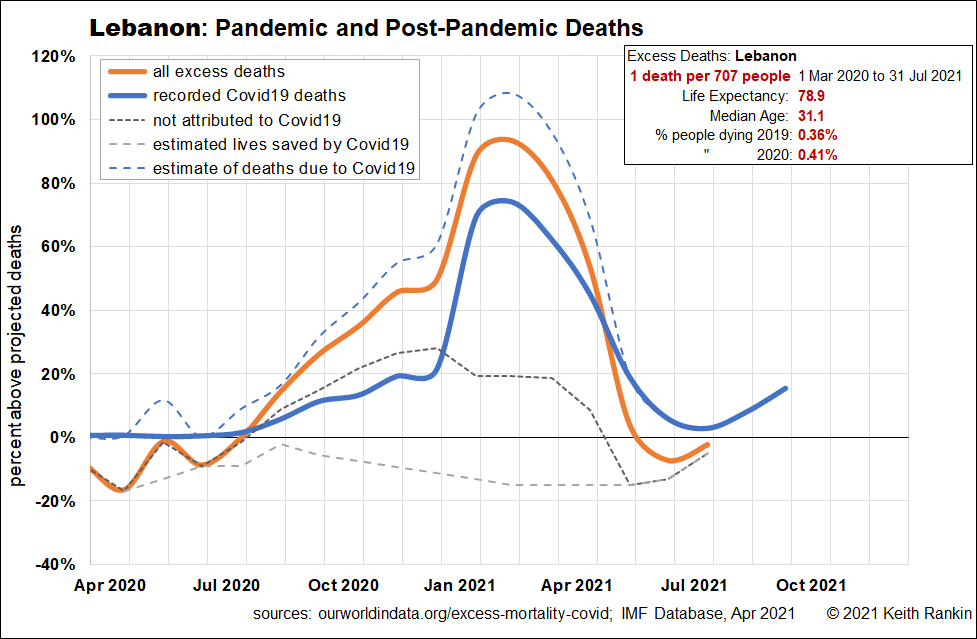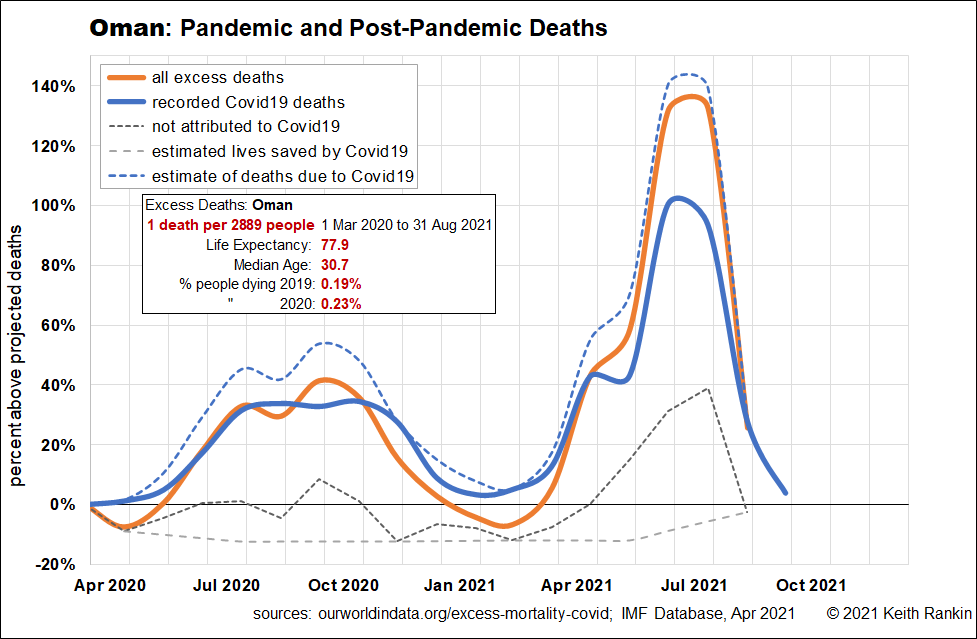Analysis Keith Rankin, 12 Oct 2021

Egypt is the world’s 14th largest country by population. It’s the one of the only two African countries on the ourworldindata database. It’s also a major travel destination. The excess deaths data reveals that Egypt has suffered far worse from the Covid19 pandemic than the official reported data indicates, with a huge peak in May 2020. It has had two major waves since then.
While Egypt’s life expectancy is similar to Russia’s, its population is substantially younger. Hence Egypt’s ‘percentage of people dying’ is much lower than Russia’s, and is indeed comparable with New Zealand’s ‘percentage of people dying’. Also, excess deaths at ‘1 in 531’ is mainly better than Russia’s because Egypt has relatively fewer people in the 60 to 80 age range. (In New Zealand terms, 1 in 531 is just under 10,000 deaths.)
My sense is that Egypt’s covid death waves are driven by foreign visitors, and by Egypt’s economic dependence on tourism. That dependence would be a reason why Egypt’s authorities might be happy for their country to fall under covid’s statistical radar.

Lebanon – with its cedar tree emblem – is of particular interest because it has been through so much of late, from Syrian refugees, explosions, economic collapse to power failure. Currently, Lebanon’s power grid has shut down due to the country’s inability to purchase fuel. In the 1960s, Lebanon was known as the Switzerland of the Levant; Beirut was the financial centre of the Middle East, and the free press enabled journalists like Robert Fisk to live and work there.
Life expectancy is surprisingly high – though will soon be much lower – thanks in part (but not only) to its quite young population.
While Lebanon largely avoided the west’s April/May 2020 wave of covid mortality, in a weakened state it certainly caught the next wave, and could not shake it off. This will have been much compounded by the huge August 2020 port explosion in Beirut. Covid19 deaths peaked in February. They are clearly rising again, with the economic collapse in the third quarter of 2021. We can expect excess deaths to again rapidly outstrip reported deaths. We can also expect substantial delays in death registrations.
Unlike Egypt and Russia, the data clearly shows that pandemic excess deaths are ‘negative’ in Lebanon when there is no current outbreak. This is the impact of anti-covid public health measures. This indirect impact of the covid pandemic is estimated on this chart as “estimated lives saved by Covid19”. And, these lives ‘saved’ mean that actual deaths (ie gross deaths) due to Covid19 exceed excess deaths. The blue dashed lines represents the best estimate of gross deaths from Covid19. The peak gross death rate from Covid19 exceeded 100% of what deaths would have been had deaths in 2020 and 2021 followed the trend set from 2015 to 2019.

Qatar is a little Arabian peninsula oil-rich nation which has become a global centre for communications, sport, and diplomacy. It’s had a recent spat with it’s envious neighbours. Despite having only half of New Zealand’s population, and a hot desert climate, it will host the 2022 Football World Cup. Ironically, that destination appears to have been a great choice, given the ructions caused elsewhere by Covid19.
Nevertheless, Qatar has been affected by Covid19 more than most people realise. It’s excess death toll of 1 person in 3525 is low only because of it’s extraordinary demographics. While Qatar’s population is not nearly as young as Egypt, it is a country dominated by young and youngish working-age people. It is a country of denizens, including many very successful resident non-citizens. The percent of Qatar’s population who die each year is extraordinarily low, because its population is dominated by people in the age cohorts who are least likely to die.
As might be expected in an international hub, Qatar has caught all of the ‘world-waves’ of the covid pandemic. Though not so much the Delta wave, thanks to a mix of high natural immunity and high vaccination rates. Life in Qatar at present is much as normal, and probably with the greatest number of international passenger movements in the world. The first covid mortality peak happened in June 2020, when there was a big expansion in those passenger movements. Perhaps more importantly, the mortality peak indicates infections in May, which was the month of Ramadan.
Low points in April and November 2020 indicate that Qatar did take public health measures against Covid19. Qatar’s biggest covid-peak was that, in April 2021, associated with the alpha-variant of the coronavirus. The size of this peak suggests that natural immunity against Covid19 was at a low point in February and March this year. During the April 2021 peak, the number of working-age people who died as a result of Covid19 was close to double the usual death rate for working-age people. Probably most of these deaths were relatively low-paid guest-workers from Asian countries.

Finally, Oman. New Zealanders know little of Oman, but as a neighbour of United Arab Emirates (UAE), many have flown over Oman, en route to or from Dubai. It is a relatively stable Arabian Peninsula country which has modernised more slowly than its better known Persian Gulf neighbours. It does employ a significant number of foreign educators, as its neighbours do. And Oman will co-host the T20 Cricket World Cup this month, though New Zealand will probably not play there.
Though not as high as Qatar’s, Oman’s life expectancy is high. And its death percentages also indicate a relatively high working age population, though not as shewed to the centre as is Qatar’s population.
Oman avoided the June covid-peak that Qatar suffered, but did get it later and for longer, most probably in association with its neighbours UAE and Saudi Arabia. The first part of the first peak mostly reflects infections acquired during Ramadan.
Oman’s biggest – and substantial – peak was in June and July 2021, and has a similar two month delay relative to Qatar. This was the alpha peak which swept the world in the northern spring and early summer. So far there is no sign in the mortality data of the delta strain of Covid19 in Oman. This – like Qatar – will be linked to both alpha-induced immunity, and vaccination. Oman had vaccination rates similar to New Zealand’s rates at the end of August 2021. New Zealand’s rates are now higher, though not dramatically so.
Keith Rankin (keith at rankin dot nz), trained as an economic historian, is a retired lecturer in Economics and Statistics. He lives in Auckland, New Zealand.







